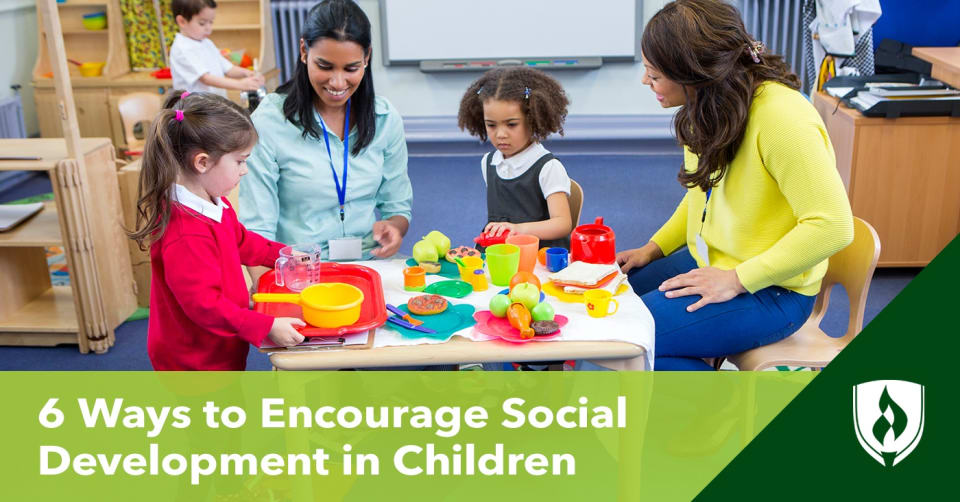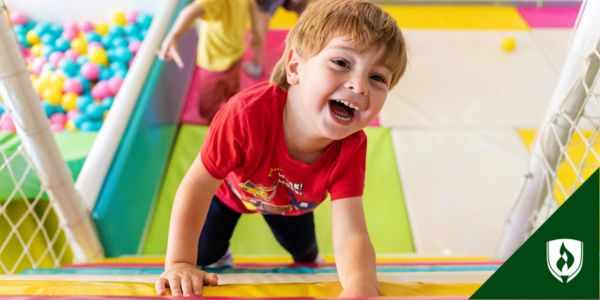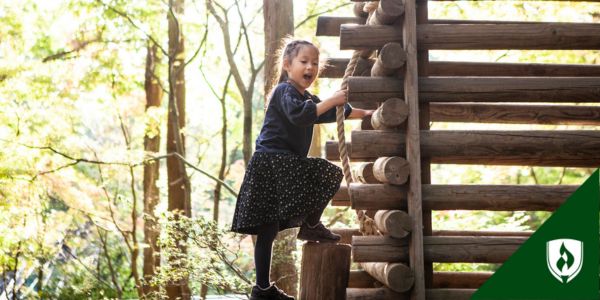
Forming a line at a service counter. Giving a polite nod of acknowledgement to a passerby. Not abruptly walking away from someone who’s mid-sentence. You might assume these are just social habits that come naturally, but in reality, navigating social situations is a skill that needs to be developed from a young age.
While much of our ability to navigate social situations comes from learning via simple observation and experimentation, there are still more proactive approaches you can take. With the recent pandemic potentially limiting opportunities for children’s social interaction and development, it may be more important than ever to take an intentional approach toward building those skills.
So how can you make that happen? We asked early childhood education professionals to offer insight into some simple methods of getting preschool-age children to practice and develop their social interaction abilities. Read on for some excellent tips and ideas!
6 Ways you can help children develop their social skills
Getting kids acclimated to social situations doesn’t have to be a high-effort ordeal. Below are several approaches you can take to help give your little one’s social skill development a boost.
1. Provide plenty of time and guidance for imaginative play
When many of us hear the phrase “imaginative play,” we might think of costumes and props, perhaps remembering our own childhood experiences: “playing house” or pretending to run a restaurant, school or store. While these tried-and-true activities are still excellent ways for kids to have fun and learn to be together, they also require more than just fun outfits or a miniature kitchen set. Young children also need time and guidance, says Susan Bracken, an early childhood educator with 40 years in the field.
Bracken offers the example of “playing restaurant” and explains that the children will need ample time to set up their scene and assign roles: who is the cook, server, customer, etc.
“This negotiation time is valuable, and an observant teacher will allow children to work out conflicts, collaboratively problem solve and find necessary props while interacting as little as possible,” says Bracken.
The adult observing this imaginative play can watch for kids who are hanging back or being left out, gently helping them join the others, offering the child phrases they can use to ask to participate, or assigning them a task that needs doing.
“The key is plenty of time for children to negotiate and problem solve,” says Bracken.
2. Create space and opportunity for unstructured play
While imaginative play can be observed and supervised, there is also much a young child can learn from unstructured and uninterrupted play time.
“The human being is designed to learn through play and imitation in early childhood,” says Rebecah Freeling, a childhood behavior expert and parent coach at Wits’ End Parenting®. “If you’re lucky enough to live where other kids are, let your child go out and play.”
Freeling says parents and other caregivers can supervise “without hovering,” she adds.
“Giving kids lots of free play time really does help,” Freeling says. If things aren’t going well, or there’s too much conflict for the interaction to be helpful, Freeling recommends rethinking the actual situation.
“Some environments are too structured or adult driven,” Freeling continues. “Kids don’t get time to really get into a play scenario where the skills can naturally develop.”
It might feel a little counterintuitive to someone actively looking for ways to promote a child’s social development, but it’s okay to take a step back and let children naturally work through social situations. Learning sometimes takes the freedom to make a mistake and learn from it—so try to resist the urge to intervene if things aren’t going perfectly initially.
3. Identify real-time emotions and model positive communication
Children have a variety of abilities to recognize emotions or understand turn-taking. There are some kids who live in situations where they have limited experience in good problem-solving and other kids who struggle with speech and language.
This is where adults and parents can step in and model awareness, Bracken says. She gives a few examples:
“Look at Susie’s face! I see that she looks sad! I see tears. I see that she’s stopped smiling.”
Taking a moment to point out these specific reactions and behaviors helps kids know what to look for, regardless of their temperament or experience.
“There may be reasons that eye contact just isn’t possible for a child,” continues Bracken. “While it can be learned in some cases, it may be painful and uncomfortable for some children. In that case, just teaching a child to turn their body toward someone may be a good substitute.”
Bracken also advises adults to verbalize to children when they see behavior that is prosocial: “I see Bill and Mary sharing a ball!” or “Jimmy and Joanie are taking turns with the slide.”
This acknowledgement of what seems obvious is sort of like “showing your work” in a math class—by explaining what you’re observing and the connections you’re making to these observations, children can more easily pick up on why people do the things they do.
4. Honor differences in personality and temperament
Along with openly and clearly identifying good communication and real-time emotions, it’s also important to remember that every child is different and to honor their methods and preferences (as long as they are not hurting themselves or anyone else).
“A child who is slow to warm up may seem unfriendly compared to a more outgoing child,” says Bracken. “But their need to be included is just as important.” Bracken believes that it’s important for caregivers and educators to get to know the children as well as their families.
“It’s really important for teachers to really understand each child’s strengths and challenges,” Bracken says.
Freeling emphasizes the importance of affirming children in how they are because kids on either end of the social spectrum—introverted or outgoing—are the ones parents and caregivers must look for.
“Both ends of that spectrum can cause issues because they can make other kids—and adults—uncomfortable,” Freeling says. “Those kids need extra attention to make their social experience pay off.”
Freeling advises parents and caregivers to accept each child just as they are.
“Don’t coax a slow to warm child; just accept them,” explains Freeling. “In fact, compliment them! Say, ‘You are so wise to stand back and watch before you join the group. That’s a really smart thing to do. Come whenever you’re ready.’”
5. Experience and discuss stories together
The simplest activities are sometimes the best ones for encouraging social development, and storytelling is another primal human activity. Reading together, watching movies or shows as a family, and then taking time to discuss what you’ve all seen is a great way to model turn-taking, listening and respectful communication. This can be done with a campfire story, picture book or movie night on the sofa with lots of popcorn.
Once you’ve had the shared experience of the story, whether in a book or television show or over s’mores, you can refer back to the events and the characters, looking at their choices, the funny things they said or did, and the ways they managed problems.
This can be as complicated or simple as you desire, but it’s a great way to safely practice social interaction.
“Tell stories, read books, discuss interactions you see on shows and movies,” Freeling suggests.
6. Seek insight from education professionals
There are many resources online that parents and caregivers can access for fun activity ideas. But Bracken suggests one source that is often forgotten: ECE professionals, childcare providers and other early childhood family education (ECFE) teachers. Some states require evaluations of young children on a variety of metrics for entrance into public schools; for example, the state of Minnesota requires screenings on a variety of metrics: cognitive, physical, language and speech, fine and gross motor skills, emotional development, and more.
“Most high-quality preschool programs will require teachers to assess children in all domains twice per year, and these assessments, which are research based, will guide teachers and parents to help children’s social development,” says Bracken.
Bracken also recommends ECFE classes as these offer parents and caregivers opportunities to observe professionals model play and social development strategies that they can use at home.
Freeling believes there is a wealth of resources that professionals can offer but cautions that the best methods and philosophies are those that fit the specific child.
“If you read something and it doesn’t fit your child, keep looking,” Freeling says.
Keeping up as they grow
Watching children learn and grow both physically and mentally is one of the biggest joys of working as an early childhood educator. But how do you know if the children under your watch are on track with their development? Our article “Early Childhood Development Milestones: What You Should Know” can provide some helpful guideposts and expert insight to keep in mind.
Wits’ End Parenting is a registered trademark of Wits’ End Parenting, Inc.
Related Articles:
- Problem Solving for Preschoolers: 9 Ways to Strengthen Their Skills
- 10 Fun Exercises for Preschoolers That Do More Than Just Burn Energy
- I Love Teaching: Preschool Pros Share What They Love About the Job
- Providers Share 6 Things You Should Know Before Starting a Home Daycare
- 4 Types of Learning Styles: How to Accommodate a Diverse Group of Students
- Running a Home Daycare: The Business Advice You Need to Succeed
- Experts Share 6 Things You Should Know Before Working with Kids




